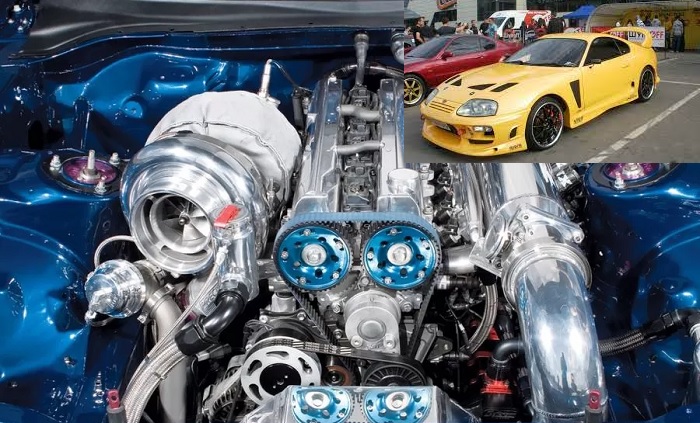If you are a fan of Toyota, then you probably know about the JZ series of engines. These are the line-six units which means they all have 6 cylinders but these cylinders are not shaped in a V-pattern like in most engines of this kind. They are arranged in one line just like in most 4-cylinder engines.
Toyota first introduced the JZ engine in 1990 and the company was offering this type of engine up until 2007. The units offered 2.5 liters to 3 liters of displacement. There were a lot of versions, and they all had their features. So, speaking about all engines in the family will take too much time. So, we decided to get a closer look at the 2JZ-GTE which is one of the coolest engines in the series.

Key features and my opinion about the engine
- Production years:1991-2002
- Average lifespan of 2JZ-GTE:310,000-350,000 miles
- Fuel supply type:port injection
- Power range:280-330 hp
- Fuel efficiency:awful
- Engine block material:cast-iron
- Engine reliability score:high
- The most common problems:turbocharger issues, drive belt is weak, VVTi phaser may break early, water pump is too weak.
Specs and features - is the 2JZ-GTE actually good?
In 1991, the company introduced the 2JZ series and one of the main engines in the series was the 2JZ-GTE. The engine inherited all interesting options from the 2JZ and also added some features that made it special. You may know that if you see the GTE letters in the name of any Toyota engine, you are looking at a unit made for sport.
The 2JZ-GTE was created for Toyota Aristo V but it became popular under the hood of the Toyota Supra RZ. The main important feature that was pretty rare for a 1990s engine was the twin-turbocharger. Even now, this feature is mainly available for racing cars only.
Here are some features of the 2JZ-GTE engine you may want to know:
- this is an inline 6-cylinder engine with quite a simple and classic construction;
- twin-turbocharger and a special type of intercooler make it good for racing;
- the top power was 276 horsepower (later 320 hp) which is really good for a 3-liter engine;
- 333 lb-ft of torque seems quite good for the early 1990s;
- the turbochargers were developed together with Hitachi;
- the main transmission was the 6-speed manual unit developed with Getrag, but there also was a 4-speed automatic transmission.
The 2JZ-GTE was introduced on the Toyota Aristo JDM model. It means that this model was only sold in Japan and wasn't exported to other countries. The engine was so interesting that even now some people want to import those JDM Aristo cars to get access to the engine with its performance and reliability.
Later, the company installed this engine on Toyota Supra RZ and Toyota Supra Turbo and sold these Supras in different countries. But we want to say that you will not find a lot of cars with this engine in the US. If you want exactly the 2JZ-GTE, you will have to spend some time finding the vehicle powered by this engine. But is it worth it? Let's think.
The lifespan of the 2JZ-GTE engine
Toyota fans know for sure that the classic Toyota engines may last for decades and still be OK. But can you apply that paradigm to the racing engines? Now we'll think about the longevity of this engine and will try to find evidence of its long (or maybe short) life.
First of all, you need to know that this engine is being hunted for in the world. Mechanics know well that this is a really good unit that is going to withstand even more power after tuning and installing better turbochargers. And this is why these engines are so wanted - they can be tuned.
Here are some facts about longevity you should know:
- the average longevity of the 2JZ-GTE is thought to be about 200 000 miles;
- you need to understand that racing use will sharply decrease the mileage of the engine;
- maintenance is important, especially for older engines that were made in the early 1990s;
- the engine will go only about 80 000 miles if you use it for car sports;
- the engine will lose its reliability if you don't service it correctly and regularly;
- professional racing engines will live an even shorter life - about 15 000 miles and sometimes more;
- tuned engines lose their longevity and will be able to go 30% fewer miles than the stock engines.
These are important things you should know about the 2JZ-GTE. Because we know cases when people bought Supras with 100 000 miles on the clock and thought that it was a good choice. But then they got a lot of problems with the engines and transmissions just because the cars had been used for racing.
You never know how a previous owner was driving the car, so you have to be very careful when buying a used 2JZ-GTE. This is a racing engine with two turbochargers that is often tuned and not always properly maintained. So, the lower mileage you see in a car, the better. But even low-mileage vehicles are not always a good choice with the 2JZ-GTE engine.
How to prolong the life of the 2JZ-GTE?
- First of all, remember about regular maintenance. Otherwise, dirty oil, bad filters, and also a worn-out belt will destroy the engine quickly.
- Then, don't try to get more horsepower and torque by tuning your engine. It's already tuned by Toyota if you compare it with the 2JZ-GE.
- You may rev up this engine because it's made for this, but keep an eye on possible overheating - this is a deadly danger for your Toyota unit.
- Use the engine in different rotations, sometimes you should press the gas pedal to the metal because this engine needs to breathe.
- Use recommended oil type and also high-quality parts. Otherwise, you will not be able to drive your car for a long time without any problems.
- Keep an eye on different possible problems and malfunctioning elements and visit a car repair shop without delays to get rid of problems.
- Be careful with the high-mileage engines. The 2JZ-GTE may just fail, problems with turbochargers may come, and sometimes it may start burning a lot of oil.
What are the main problems of the 2JZ-GTE?
When we are talking about common problems with an engine, we usually just create a list of bad things that can happen with your engine. But in this case, we can't just make this list because the engine will show a certain range of problems depending on the way you use it. For example, on a racing car, you will get one set of problems. But if you use your Supra for just fun city driving, the range of breakdowns will be absolutely different.
We'll try to combine those two main factors and outline the major problems you may get with your 2JZ-GTE engines. Here are the most important ones:
- One of the problems is misinformation. We've found a lot of statements on the internet saying that this engine block is capable of 2000 hp. It's nonsense. It can hold up to 500 hp and even this boost will shorten its life twice.
- The timing belt system is not that reliable. And this problem can lead to a very expensive head repair. If a timing belt breaks, it leads to valves kicking the pistons and getting damaged.
- Oil pump problems. This is a racing engine, so the oil pump should be one of the most reliable parts here. But it's a little different. The oil pump seal can blow out at any time and this will lead to a problem that you don't see but it destroys your engine slowly.
- Cylinder head cooling is not that good. And this is something racing guys try to change because otherwise, revving up this engine can eventually cause huge problems.
- The twin-turbo system is not the best in its class. A lot of racing fans recommend replacing the twin-turbo of Toyota with some other turbo kit with more or less up-to-date specs.
As you see, the 2JZ-GTE engine still has a lot of problems. If you drive your Supra like a family car, it will go around 200 000 miles which is not that good. The V6 block with big displacement should last longer.
Also, repairing the 2JZ-GTE is a big challenge because finding good parts is really hard. Let alone finding a good mechanic.
Final words
If you are a fan of racing Toyota technologies, the 2JZ-GTE is a really cool engine to consider. But don't think that it's an ideal unit with no downsides at all. This engine is really cool in terms of power and torque if you compare it with other units in the class, but it's not that reliable. A lot of minor problems will happen even if you don't want any sport from your Toyota engine. And the expenses for repair may be too depressing sometimes.
About the authors
The CarAraC research team is composed of seasoned auto mechanics and automotive industry professionals, including individuals with advanced degrees and certifications in their field. Our team members boast prestigious credentials, reflecting their extensive knowledge and skills. These qualifications include: IMI: Institute of the Motor Industry, ASE-Certified Master Automobile Technicians; Coventry University, Graduate of MA in Automotive Journalism; Politecnico di Torino, Italy, MS Automotive Engineering; Ss. Cyril and Methodius University in Skopje, Mechanical University in Skopje; TOC Automotive College; DHA Suffa University, Department of Mechanical Engineering






Add comment